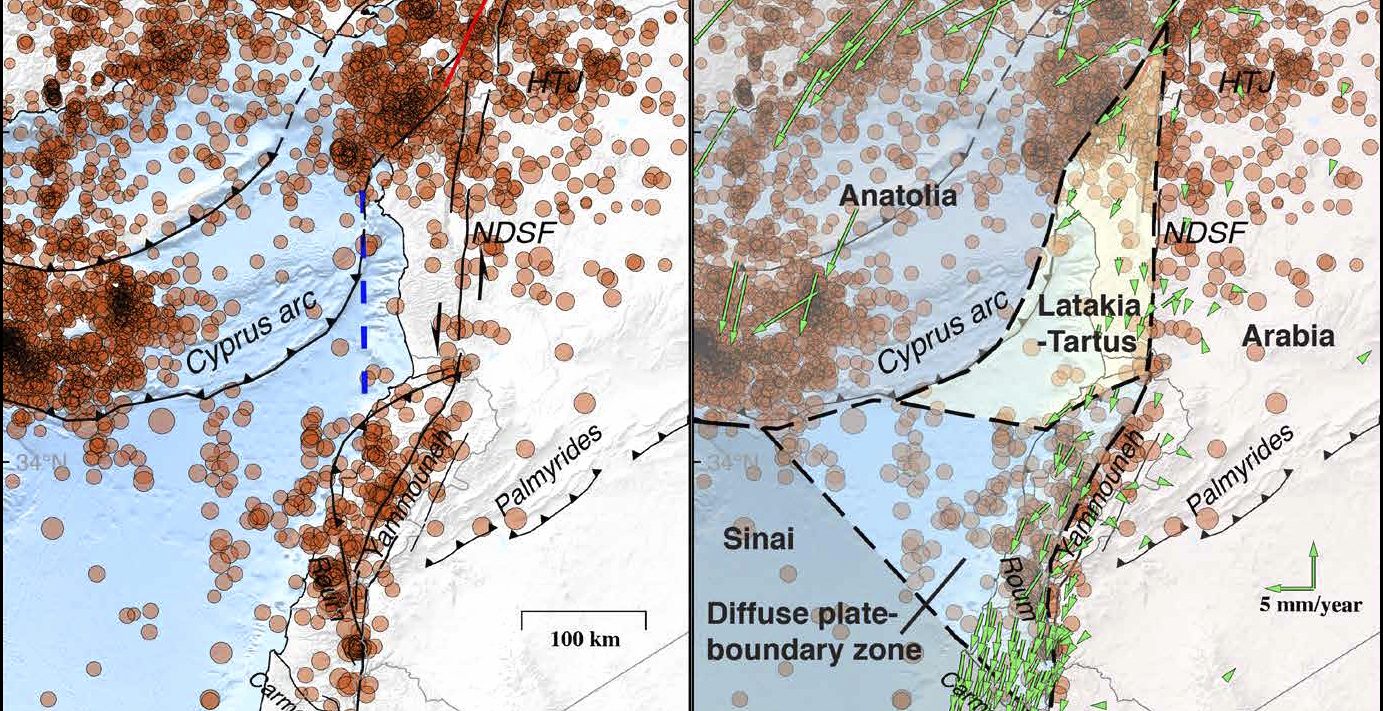A new tectonic micro-plate identified north of the Dead Sea Fault
In a study published in Science Advances, an international team has systematically analysed Sentinels-2 radar images to identify a new tectonic micro-plate in the zone where the Arabian and Anatolian plates meet, to the north of the Dead Sea Fault.

Publication date: 17/05/2024
Press, Research
Related teams :
Tectonics and Mechanics of the Lithosphere
The Dead Sea fault is a major tectonic structure in the Mediterranean area, that forms the western boundary of the Arabian plate. It is a left-lateral strike-slip structure around 1,200 km long, which connects the oceanic extension of the Red Sea with the continental collision zone of the Caucasus and the East Anatolian Fault. Ruptures along the latter fault caused two major earthquakes in February 2023, of magnitude Mw7.8 and Mw7.6 respectively. In this active region, it is therefore vital to understand the geometry and dynamics of these different structures, in order to identify whether major earthquakes could also occur along the Levant fault.
To understand the history and evolution of these structures, scientists are using several types of complementary data, including archaeological ruins and geomorphological traces left by ancient earthquakes, as well as recent GPS data that can be used to measure the instantaneous speed of the fault. While the Dead Sea Fault is very well documented historically in its southern and central parts, it is less well documented in the north of Lebanon. Up to the transpressive bend in Lebanon, the two velocities, measured either by GPS or using geomorphological approaches, converge around a value of 4±1 mm/year. On the other hand, in the north, where the study of the fault is essentially based on the study of offsets documented in archaeological sites, these displacements on a geological scale, of the order of 4±1 mm/year, are not consistent with recent geodetic data, of the order of 1 to 2 mm/year.
In an attempt to resolve this inconsistency, an international team, including a CNRS researcher from the IPGP, systematically used Sentinels-2 radar images to measure the horizontal speed along the entire Levant fault.
In a study published on 15 March in the journal Science Advances, they demonstrate that the reduction in the speed of the fault from the south to the north of Lebanon is real.
In the same study, based on observations made along the southern part of the fault, where seismic activity occurs in the form of a temporal cluster, Yann Klinger and his colleagues were able to show that the probability of two earthquakes occurring in a short interval of time, leading to an overestimation of the geological velocity, is significant and may have been behind the overestimation of the archaeological velocity of the fault.
In addition, the precise relocation of seismicity in the eastern Mediterranean shows that there is persistent seismicity to the north of the fault, known as the Carmel Fault, that directly connects the Dead Sea Fault to the Cypriot subduction system, while the area to the south of this same fault is completely devoid of seismicity.
Taken together, these observations suggest that the zones to the south and north of this discontinuity behave differently and correspond to different independent tectonic micro-plates, thus explaining the difference in speed observed between the north and south of the Levant fault. The scientists in the team have named this new northern micro-plate Latakia-Tartous
References:
> Xing Li et al., Resolving the slip-rate inconsistency of the northern Dead Sea fault. Sci. Adv. 10 (2024). DOI : 10.1126/sciadv.adj8408







